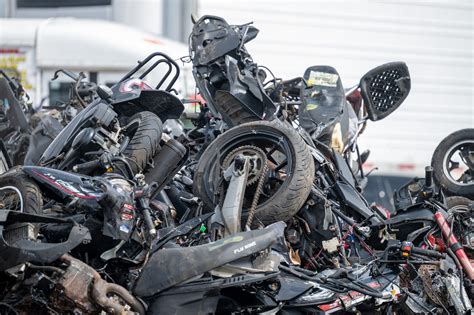
Outrage is mounting in Galveston, Texas, after residents discovered a large-scale dumping of bizarre and concerning items along the city’s beaches, including children’s toys, clothing, medical supplies, and potentially hazardous materials, sparking environmental and public health worries.
GALVESTON, Texas – Residents and local officials in Galveston are grappling with the aftermath of a massive and bewildering dumping incident that has left the city’s shores littered with an assortment of unexpected and potentially dangerous items. The debris, discovered across multiple beach locations, ranges from everyday household goods to medical waste, raising serious concerns about environmental contamination and public safety.
The disturbing scene, first reported by local beachgoers over the weekend, quickly garnered attention on social media, with images of the strewn items circulating widely. The photographs depict a disturbing array of objects, including children’s toys, articles of clothing, personal care products, and, most alarmingly, medical supplies such as vials and syringes.
“It’s just unbelievable, the things that are washing up,” said one Galveston resident, quoted by local news outlets. “This isn’t just your average litter; it’s like someone emptied out a house and a doctor’s office onto our beaches.”
The source of the dumped material remains under investigation. Initial speculation centered on the possibility of a cargo spill from a passing ship, but authorities are also exploring other potential causes, including illegal dumping and improper waste disposal practices. The U.S. Coast Guard has been notified and is assisting in the investigation.
The discovery has ignited a firestorm of criticism from local residents, environmental groups, and elected officials, all demanding swift action to identify the source of the debris and prevent similar incidents in the future.
“This is an outrage,” stated Galveston Mayor Craig Brown in a press conference held Monday morning. “Our beaches are a vital part of our community and our economy, and we will not tolerate this kind of blatant disregard for our environment and the safety of our citizens. We are committed to finding those responsible and holding them accountable to the fullest extent of the law.”
The immediate priority is the cleanup operation, which is being coordinated by the Galveston Parks and Recreation Department in conjunction with volunteer organizations and environmental cleanup crews. Authorities are urging residents to exercise caution when visiting the affected beaches and to avoid handling any of the debris, especially medical waste.
“We are working as quickly as possible to remove the debris and restore our beaches to their natural state,” said Kelly de Schaun, Director of the Galveston Parks and Recreation Department. “However, we also need the public’s cooperation. If you see something, say something, and please do not touch any of the potentially hazardous materials.”
The incident has also prompted calls for increased surveillance and stricter enforcement of environmental regulations in the Galveston area. Local officials are considering measures such as enhanced beach patrols, increased fines for illegal dumping, and improved monitoring of waste disposal practices at local medical facilities.
Beyond the immediate cleanup efforts, the long-term ecological consequences of the dumping incident are a major concern. Environmental experts warn that the debris could contaminate the sand and water, harming marine life and potentially disrupting the local ecosystem.
“The chemicals and toxins released from these materials could have a devastating impact on the marine environment,” explained Dr. Erin Kinney, a marine biologist at Texas A&M University at Galveston. “We need to conduct a thorough assessment of the extent of the contamination and take steps to mitigate the damage.”
The incident in Galveston is not an isolated one. Coastal communities around the world are increasingly facing the challenges of marine pollution and illegal dumping, driven by factors such as increased shipping traffic, inadequate waste management infrastructure, and a lack of environmental awareness.
The Galveston dumping incident serves as a stark reminder of the urgent need for greater vigilance and proactive measures to protect our oceans and coastal environments. It also highlights the importance of individual responsibility in preventing pollution and ensuring the sustainable use of our natural resources.
As the investigation continues and the cleanup efforts proceed, the residents of Galveston remain determined to restore their beloved beaches and hold those responsible for this environmental transgression accountable.
Detailed Breakdown and Contextual Information
The recent dumping incident on Galveston beaches has exposed a complex web of interconnected issues, ranging from waste management practices to environmental regulations and the potential impact on the local economy. This comprehensive overview delves deeper into the various facets of the situation, providing a detailed understanding of the incident and its broader implications.
Source of the Debris: Unraveling the Mystery
Identifying the source of the dumped material is paramount to holding the responsible parties accountable and preventing future occurrences. While the investigation is still ongoing, several potential scenarios are being explored:
-
Cargo Spill: The initial suspicion centered on the possibility of a cargo spill from a passing ship. Galveston is a major port city with heavy maritime traffic, making it plausible that containers carrying various goods could have been lost overboard due to rough seas or improper securing. Authorities are reviewing shipping manifests and tracking data to identify any vessels that may have been in the area at the time of the dumping.
-
Illegal Dumping: Another possibility is that the debris was deliberately dumped from a land-based source, either by individuals or businesses seeking to avoid proper disposal fees. This could involve the transportation of waste materials to a secluded location near the beach and then dumping them under the cover of darkness. Investigators are examining surveillance footage from nearby businesses and conducting interviews with local residents to gather information about any suspicious activity.
-
Improper Waste Disposal: A third possibility is that the medical waste and other hazardous materials originated from local hospitals, clinics, or research facilities that failed to adhere to proper waste disposal protocols. This could involve the accidental or intentional discarding of materials into regular trash streams, which then ended up on the beaches. Authorities are reviewing the waste management practices of local medical facilities to ensure compliance with regulations.
The Environmental Impact: A Looming Threat
The environmental consequences of the dumping incident are potentially far-reaching and could have long-lasting effects on the Galveston ecosystem. Some of the key concerns include:
-
Contamination of Sand and Water: The debris, particularly the medical waste and chemical substances, could leach toxins into the sand and water, contaminating these vital resources. This could pose a risk to human health through direct contact with the contaminated materials or through the consumption of contaminated seafood.
-
Harm to Marine Life: Marine animals, such as seabirds, turtles, and fish, could ingest or become entangled in the debris, leading to injury, illness, or death. The toxins released from the debris could also poison marine life, disrupting the food chain and potentially causing population declines.
-
Habitat Destruction: The accumulation of debris on the beaches could smother sensitive habitats, such as seagrass beds and oyster reefs, which provide critical breeding and feeding grounds for marine life. The debris could also alter the physical characteristics of the beaches, making them less suitable for nesting seabirds and other wildlife.
-
Microplastic Pollution: Plastic debris, which is a significant component of the dumped material, could break down into microplastics over time. Microplastics are tiny plastic particles that can be ingested by marine animals and accumulate in the food chain, potentially posing a risk to human health.
The Public Health Risks: A Growing Concern
The presence of medical waste and other potentially hazardous materials on the beaches poses a direct threat to public health. Some of the key risks include:
-
Infection: Exposure to medical waste, such as syringes and vials, could lead to infections from bacteria, viruses, or other pathogens. This is particularly concerning for children, who may be more likely to pick up and play with the debris.
-
Chemical Exposure: Contact with chemical substances, such as cleaning products or pesticides, could cause skin irritation, respiratory problems, or other health effects. The long-term effects of exposure to these chemicals are not fully understood.
-
Physical Injury: Sharp objects, such as broken glass or metal fragments, could cause cuts, scrapes, or other injuries.
Economic Implications: A Threat to Tourism
Galveston’s economy is heavily reliant on tourism, and the dumping incident could have a significant negative impact on the industry. The presence of debris on the beaches could deter tourists from visiting the area, leading to a decline in hotel occupancy rates, restaurant sales, and other tourism-related revenues.
The incident could also damage Galveston’s reputation as a clean and attractive tourist destination, making it more difficult to attract visitors in the future.
Legal and Regulatory Framework: Holding Polluters Accountable
Several laws and regulations are in place to protect the environment and prevent illegal dumping. These include:
-
The Clean Water Act: This federal law regulates the discharge of pollutants into waterways, including the ocean. It prohibits the dumping of harmful materials into the ocean without a permit.
-
The Resource Conservation and Recovery Act (RCRA): This federal law regulates the management of hazardous waste, including medical waste. It requires generators of hazardous waste to properly store, transport, and dispose of their waste.
-
State and Local Environmental Regulations: Texas and the city of Galveston have their own environmental regulations that prohibit illegal dumping and protect water quality.
Violations of these laws and regulations can result in significant fines, penalties, and even criminal charges.
Community Response and Cleanup Efforts:
The Galveston community has rallied together to address the dumping incident, with numerous volunteer organizations and individuals participating in cleanup efforts. The Galveston Parks and Recreation Department is coordinating the cleanup operations, providing equipment and supplies to volunteers and ensuring that the debris is properly disposed of.
Local businesses have also stepped up to support the cleanup efforts, donating resources and providing assistance to volunteers.
Preventive Measures: A Proactive Approach
Preventing future dumping incidents requires a multi-faceted approach that addresses the root causes of the problem. Some of the key preventive measures include:
-
Increased Surveillance: Enhancing surveillance of beaches and coastal areas can help deter illegal dumping and identify potential sources of pollution. This could involve the installation of security cameras, increased beach patrols, and the use of drones to monitor remote areas.
-
Stricter Enforcement: Stricter enforcement of environmental regulations can help hold polluters accountable and deter future violations. This could involve increasing fines for illegal dumping, conducting more frequent inspections of waste disposal facilities, and prosecuting individuals and businesses that violate environmental laws.
-
Improved Waste Management: Improving waste management infrastructure and practices can help prevent waste from ending up in the environment. This could involve expanding recycling programs, providing more convenient waste disposal options, and implementing stricter regulations for waste disposal facilities.
-
Public Education: Educating the public about the importance of environmental protection and the consequences of illegal dumping can help raise awareness and encourage responsible behavior. This could involve conducting public awareness campaigns, organizing community cleanups, and providing educational materials to schools and community groups.
-
International Cooperation: Addressing marine pollution requires international cooperation, as pollution can travel across borders. This could involve working with other countries to develop and implement international agreements on marine pollution prevention and control.
The Galveston dumping incident serves as a wake-up call for coastal communities around the world. It underscores the urgent need for greater vigilance, proactive measures, and a collective commitment to protecting our oceans and coastal environments. Only through a concerted effort can we prevent future incidents like this from occurring and ensure the sustainable use of our natural resources.
The Role of Technology in Addressing Marine Pollution
Technology is playing an increasingly important role in addressing marine pollution, offering innovative solutions for monitoring, cleanup, and prevention. Some of the key technological advancements in this area include:
-
Satellite Monitoring: Satellites equipped with advanced sensors can be used to monitor ocean pollution, detect oil spills, and track the movement of marine debris. This information can be used to identify pollution hotspots, assess the extent of damage, and guide cleanup efforts.
-
Drones: Drones can be used to conduct aerial surveys of beaches and coastal areas, identifying areas affected by pollution and mapping the distribution of debris. Drones can also be used to collect samples of water and sediment for analysis.
-
Robotics: Robots are being developed to assist in the cleanup of marine debris, including plastic waste and oil spills. These robots can operate in harsh environments and can collect large quantities of debris efficiently.
-
Sensors: Sensors can be deployed in the ocean to monitor water quality, detect pollutants, and track the movement of marine life. These sensors can provide real-time data that can be used to inform management decisions.
-
Artificial Intelligence (AI): AI algorithms can be used to analyze large datasets of environmental data, identify patterns, and predict the spread of pollution. AI can also be used to optimize cleanup efforts and identify the most effective strategies for preventing pollution.
The Path Forward: A Call to Action
The Galveston dumping incident has exposed a complex web of environmental, economic, and social issues. Addressing these issues requires a concerted effort from individuals, communities, governments, and the private sector.
Here are some key actions that can be taken to prevent future incidents and protect our oceans:
-
Reduce Waste Generation: Reducing waste generation is the most effective way to prevent pollution. This can be achieved through waste reduction, reuse, and recycling programs.
-
Improve Waste Management Practices: Improving waste management practices can help prevent waste from ending up in the environment. This includes implementing stricter regulations for waste disposal facilities, expanding recycling programs, and providing more convenient waste disposal options.
-
Support Sustainable Businesses: Supporting businesses that are committed to sustainability can help reduce pollution and promote responsible environmental practices.
-
Educate Yourself and Others: Educating yourself and others about the importance of environmental protection can help raise awareness and encourage responsible behavior.
-
Advocate for Stronger Environmental Policies: Advocating for stronger environmental policies can help ensure that our oceans and coastal environments are protected.
-
Participate in Cleanup Efforts: Participating in cleanup efforts can help remove debris from our beaches and waterways and restore damaged ecosystems.
The future of our oceans depends on our collective action. By working together, we can create a cleaner, healthier, and more sustainable future for generations to come.
The Emotional Toll on the Community
Beyond the environmental and economic implications, the dumping incident has taken an emotional toll on the Galveston community. The beaches are not just a source of recreation and income; they are also a part of the community’s identity and heritage. The sight of their beloved beaches littered with debris has caused anger, sadness, and a sense of violation.
Many residents have expressed feelings of frustration and helplessness, wondering how such a blatant disregard for the environment could have occurred. They are also concerned about the long-term effects of the pollution on the health of their families and the future of their community.
The community’s response to the incident has been one of resilience and determination. Residents have come together to clean up the beaches, support each other, and demand accountability from those responsible. They are determined to restore their beaches to their former glory and to prevent future incidents from occurring.
The Galveston dumping incident is a reminder that environmental protection is not just a technical or scientific issue; it is also a deeply personal and emotional one. Protecting our environment is essential for the well-being of our communities and the preservation of our cultural heritage.
FAQ Section
1. What types of items were found dumped on the Galveston beaches?
The dumped items included a wide range of materials, from everyday household goods like children’s toys, clothing, and personal care products to more concerning items such as medical supplies (vials, syringes), and potentially hazardous materials.
2. What is the primary concern regarding the dumped medical waste?
The primary concern is the risk of infection from exposure to pathogens in the medical waste, as well as the potential for physical injury from sharp objects like syringes. There is also concern regarding the chemical components of certain medical supplies that can be toxic if exposed.
3. What are the potential environmental impacts of the dumping incident?
The dumping incident could lead to contamination of sand and water, harming marine life through ingestion or entanglement in debris, habitat destruction of sensitive areas like seagrass beds, and the release of microplastics into the environment.
4. What are the possible sources of the dumped materials being investigated?
The investigation is exploring several possibilities, including cargo spills from ships, illegal dumping by individuals or businesses, and improper waste disposal practices by local medical facilities or other entities.
5. What steps are being taken to address the situation and prevent future incidents?
Cleanup efforts are underway, coordinated by the Galveston Parks and Recreation Department with volunteer assistance. Authorities are considering increased surveillance, stricter enforcement of environmental regulations, improved waste management practices, and public education campaigns to prevent future incidents.









